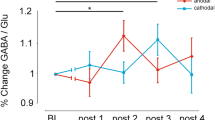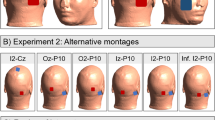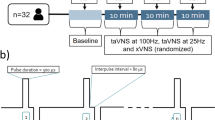Abstract
Steady-state auditory evoked responses (SSAER) obtained via electroencephalography (EEG) co-vary in amplitude with blood flow changes in the auditory area of the cerebellum. The aim of the present EEG study was to probe the cerebellar role in the control of such SSAER. For this purpose, we investigated changes in SSAERs due to transient disruption of the cerebellar hemisphere by repetitive transcranial magnetic stimulation (rTMS). SSAERs to click-trains of three different frequencies in the gamma-band (32, 40 and 47 Hz) were recorded from 45 scalp electrodes in six healthy volunteers immediately after 1-Hz rTMS and compared to baseline SSAERs assessed prior to magnetic stimulation. Cerebellar rTMS contralateral to the stimulated ear significantly reduced the amplitude of steady-state responses to 40-Hz click-trains and showed a tendency to reduce the amplitude to 32-Hz click-trains. No effects were observed for 47-Hz click-trains, nor for magnetic stimulation of the cerebellum ipsilateral to auditory stimulation or after sham stimulation. Our results suggest that interference with cerebellar output by rTMS modifies functional activity associated with cortical auditory processing. The finding of maximum effects on 40-Hz SSAERs provides support to the notion that the cerebellum is part of a distributed network involved in the regulation of cortical oscillatory activity and points at some frequency-specificity for the control of auditory-driven neuronal oscillations.




Similar content being viewed by others
References
Artieda J, Valencia M, Alegre M, Olaziregi O, Urrestarazu E, Iriarte J (2004) Potentials evoked by chirp-modulated tones: a new technique to evaluate oscillatory activity in the auditory pathway. Clin Neurophysiol 115:699–709
Azzena GB, Conti G, Santarelli R, Ottaviani F, Paludetti G, Maurizi M (1995) Generation of human auditory steady-state responses (SSRs) I: stimulus rate effects. Hear Res 83:1–8
Basar E, Rosen B, Basar-Eroglu C, Greitschus F (1987) The associations between 40 Hz-EEG and the middle latency response of the auditory evoked potential. Int J Neurosci 33:103–117
Belmonte M (1998) Shifts of visual spatial attention modulate a steady-state visual evoked potential. Brain Res Cogn Brain Res 6:295–307
Bohotin V, Fumal A, Vandenheede M, Gerard P, Bohotin C, Maertens de Noordhout A, Schoenen J (2002) Effects of repetitive transcranial magnetic stimulation on visual evoked potentials in migraine. Brain 125:912–922
Boroojerdi B, Prager A, Muellbacher W, Cohen LG (2000) Reduction of human visual cortex excitability using 1-Hz transcranial magnetic stimulation. Neurology 54:1529–1531
Brodal P (1983) Principles of organization of the corticopontocerebellar projection to crus II in the cat with particular reference to the parietal cortical areas. Neuroscience 10:621–638
Chen R, Classen J, Gerloff C, Celnik P, Wassermann EM, Hallett M, Cohen LG (1997) Depression of motor cortex excitability by low-frequency transcranial magnetic stimulation. Neurology 48:1398–1403
Chen WH, Mima T, Siebner HR, Oga T, Hara H, Satow T, Begum T, Nagamine T, Shibasaki H (2003) Low-frequency rTMS over lateral premotor cortex induces lasting changes in regional activation and functional coupling of cortical motor areas. Clin Neurophysiol 114:1628–1637
Enomoto H, Ugawa Y, Hanajima R, Yuasa K, Mochizuki H, Terao Y, Shiio Y, Furubayashi T, Iwata NK, Kanazawa I (2001) Decreased sensory cortical excitability after 1 Hz rTMS over the ipsilateral primary motor cortex. Clin Neurophysiol 112:2154–2158
Fumal A, Bohotin V, Vandenheede M, Seidel L, de Pasqua V, de Noordhout AM, Schoenen J (2003) Effects of repetitive transcranial magnetic stimulation on visual evoked potentials: new insights in healthy subjects. Exp Brain Res 150:332–340
Galambos R, Makeig S, Talmachoff PJ (1981) A 40-Hz auditory potential recorded from the human scalp. Proc Natl Acad Sci U S A 78:2643–2647
Gerschlager W, Christensen LO, Bestmann S, Rothwell JC (2002) rTMS over the cerebellum can increase corticospinal excitability through a spinal mechanism involving activation of peripheral nerve fibres. Clin Neurophysiol 113:1435–1440
Gutschalk A, Mase R, Roth R, Ille N, Rupp A, Hahnel S, Picton TW, Scherg M (1999) Deconvolution of 40 Hz steady-state fields reveals two overlapping source activities of the human auditory cortex. Clin Neurophysiol 110:856–868
Hari R, Hamalainen M, Joutsiniemi SL (1989a) Neuromagnetic steady-state responses to auditory stimuli. J Acoust Soc Am 86:1033–1039
Hari R, Joutsiniemi SL, Hamalainen M, Vilkman V (1989b) Neuromagnetic responses of human auditory cortex to interruptions in a steady rhythm. Neurosci Lett 99:164–168
Hashimoto M, Ohtsuka K (1995) Transcranial magnetic stimulation over the posterior cerebellum during visually guided saccades in man. Brain 118 (Pt 5):1185–1193
Herdman AT, Lins O, Van Roon P, Stapells DR, Scherg M, Picton TW (2002) Intracerebral sources of human auditory steady-state responses. Brain Topogr 15:69–86
Hilgetag CC, Theoret H, Pascual-Leone A (2001) Enhanced visual spatial attention ipsilateral to rTMS-induced ‘virtual lesions’ of human parietal cortex. Nat Neurosci 4:953–957
Ives JR, Mainwaring NR, Gruber LJ, Cosgrove GR, Blume HW, Schomer DL (1991) 128-channel cable-telemetry EEG recording system for long-term invasive monitoring. Electroencephalogr Clin Neurophysiol 79:69–72
Johnson BW, Weinberg H, Ribary U, Cheyne DO, Ancill R (1988) Topographic distribution of the 4 Hz auditory evoked-related potential in normal and aged subjects. Brain Topogr 1:117–121
Kosslyn SM, Pascual-Leone A, Felician O, Camposano S, Keenan JP, Thompson WL, Ganis G, Sukel KE, Alpert NM (1999) The role of area 17 in visual imagery: convergent evidence from PET and rTMS. Science 284:167–170
Linden RD, Picton TW, Hamel G, Campbell KB (1987) Human auditory steady-state evoked potentials during selective attention. Electroencephalogr Clin Neurophysiol 66:145–159
Macwhinney B, Cohen J, Provost J (1997) The psyScope experiment-building system. Spat Vis 11:99–101
Maiste AC, Wiens AS, Hunt MJ, Scherg M, Picton TW (1995) Event-related potentials and the categorical perception of speech sounds. Ear Hear 16:68–90
Makeig S, Westerfield M, Jung TP, Enghoff S, Townsend J, Courchesne E, Sejnowski TJV (2002) Dynamic brain sources of visual evoked responses. Science 295:690–694
Makela JP, Hari R (1987) Evidence for cortical origin of the 40 Hz auditory evoked response in man. Electroencephalogr Clin Neurophysiol 66:539–546
Middleton FA, Strick PL (1998) The cerebellum: an overview. Trends Neurosci 21:367–369
Muellbacher W, Ziemann U, Boroojerdi B, Hallett M (2000) Effects of low-frequency transcranial magnetic stimulation on motor excitability and basic motor behavior. Clin Neurophysiol 111:1002–1007
Muller MM, Hillyard SV (2000) Concurrent recording of steady-state and transient event-related potentials as indices of visual-spatial selective attention. Clin Neurophysiol 111:1544–1552
Ohtsuka K, Enoki T (1998) Transcranial magnetic stimulation over the posterior cerebellum during smooth pursuit eye movements in man. Brain 121 (Pt 3):429–435
Oldfield RC (1971) The assessment and analysis of handedness: the Edinburgh inventory. Neuropsychologia 9:97–113
Pantev C, Roberts LE, Elbert T, Ross B, Wienbruch C (1996) Tonotopic organization of the sources of human auditory steady-state responses. Hear Res 101:62–74
Pastor MA, Artieda J, Arbizu J, Marti-Climent JM, Penuelas I, Masdeu JC (2002) Activation of human cerebral and cerebellar cortex by auditory stimulation at 40 Hz. J Neurosci 22:10501–10506
Pfurtscheller G, Lopes da Silva FH (1999) Event-related EEG/MEG synchronization and desynchronization: basic principles. Clin Neurophysiol 110:1842–1857
Plourde G, Stapells DR, Picton TW (1991) The human auditory steady-state evoked potentials (discussion 160). Acta Otolaryngol Suppl 491:153–159
Regan D (1966) An effect of stimulus colour on average steady-state potentials evoked in man. Nature 210:1056–1057
Robertson EM, Theoret H, Pascual-Leone A (2003) Studies in cognition: the problems solved and created by transcranial magnetic stimulation. J Cogn Neurosci 15:948–960
Romero JR, Anschel D, Sparing R, Gangitano M, Pascual-Leone A (2002) Subthreshold low frequency repetitive transcranial magnetic stimulation selectively decreases facilitation in the motor cortex. Clin Neurophysiol 113:101–107
Ross B, Borgmann C, Draganova R, Roberts LE, Pantev C (2000) A high-precision magnetoencephalographic study of human auditory steady-state responses to amplitude-modulated tones. J Acoust Soc Am 108:679–691
Rossi S, Pasqualetti P, Rossini PM, Feige B, Ulivelli M, Glocker FX, Battistini N, Lucking CH, Kristeva-Feige R (2000) Effects of repetitive transcranial magnetic stimulation on movement-related cortical activity in humans. Cereb Cortex 10:802–808
Saito Y, Yokota T, Yuasa T (1995) Suppression of motor cortical excitability by magnetic stimulation of the cerebellum. Brain Res 694:200–206
Santarelli R, Maurizi M, Conti G, Ottaviani F, Paludetti G, Pettorossi VE (1995) Generation of human auditory steady-state responses (SSRs) II: addition of responses to individual stimuli. Hear Res 83:9–18
Schmahmann JD, Pandya DN (1991) Projections to the basis pontis from the superior temporal sulcus and superior temporal region in the rhesus monkey. J Comp Neurol 308:224–248
Schutter DJ, van Honk J, d’Alfonso AA, Postma A, de Haan EH (2001) Effects of slow rTMS at the right dorsolateral prefrontal cortex on EEG asymmetry and mood. Neuroreport 12:445–447
Shapiro KA, Pascual-Leone A, Mottaghy FM, Gangitano M, Caramazza A (2001) Grammatical distinctions in the left frontal cortex. J Cogn Neurosci 13:713–720
Simpson MI, Hadjipapas A, Barnes GR, Furlong PL, Witton C (2005) Imaging the dynamics of the auditory steady-state evoked response. Neurosci Lett 385:195–197
Stapells DR, Linden D, Suffield JB, Hamel G, Picton TW (1984) Human auditory steady state potentials. Ear Hear 5:105–113
Stapells DR, Galambos R, Costello JA, Makeig S (1988) Inconsistency of auditory middle latency and steady-state responses in infants. Electroencephalogr Clin Neurophysiol 71:289–295
Strens LH, Oliviero A, Bloem BR, Gerschlager W, Rothwell JC, Brown P (2002) The effects of subthreshold 1 Hz repetitive TMS on cortico-cortical and interhemispheric coherence. Clin Neurophysiol 113:1279–1285
Theoret H, Haque J, Pascual-Leone A (2001) Increased variability of paced finger tapping accuracy following repetitive magnetic stimulation of the cerebellum in humans. Neurosci Lett 306:29–32
Thut G, Theoret H, Pfennig A, Ives J, Kampmann F, Northoff G, Pascual-Leone A (2003) Differential effects of low-frequency rTMS at the occipital pole on visual-induced alpha desynchronization and visual-evoked potentials. Neuroimage 18:334–347
Touge T, Gerschlager W, Brown P, Rothwell JC (2001) Are the after-effects of low-frequency rTMS on motor cortex excitability due to changes in the efficacy of cortical synapses? Clin Neurophysiol 112:2138–2145
Ugawa Y, Uesaka Y, Terao Y, Hanajima R, Kanazawa I (1995) Magnetic stimulation over the cerebellum in humans. Ann Neurol 37:703–713
Werhahn KJ, Taylor J, Ridding M, Meyer BU, Rothwell JC (1996) Effect of transcranial magnetic stimulation over the cerebellum on the excitability of human motor cortex. Electroencephalogr Clin Neurophysiol 101:58–66
Acknowledgment
M.A.P. was supported by grant EX2001 46214114 from the Spanish Education and Culture Department MECD/Fulbright and G.T by a grant of the Swiss National Science Foundation (no 823A-061230). The study was partly supported by K24 RR018875 and RO1-EY12091 to A.P.-L and the Harvard–Thorndike General Clinical Research Center (NCRR MO1 RR01032).
Author information
Authors and Affiliations
Corresponding author
Rights and permissions
About this article
Cite this article
Pastor, M.A., Thut, G. & Pascual-Leone, A. Modulation of steady-state auditory evoked potentials by cerebellar rTMS. Exp Brain Res 175, 702–709 (2006). https://doi.org/10.1007/s00221-006-0588-2
Received:
Accepted:
Published:
Issue Date:
DOI: https://doi.org/10.1007/s00221-006-0588-2




